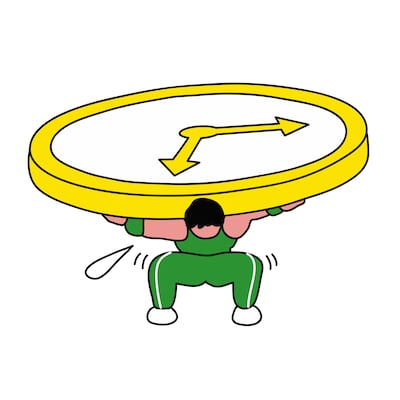We’ve all been there. You set a goal to exercise regularly, but when the moment comes to get moving, your mind unleashes a torrent of excuses: I’m tired. It’s cold outside. I don’t want to spend money on a class.

These mental blocks may explain why it’s so hard to keep a 2024 resolution for longer than four months. So, how do you cut through them?
The first step, experts say, is to stop thinking of them as “excuses”.
Just using that word can suggest you failed and should feel bad about your willpower. Research has shown that self-criticism and shame can actually stop you from meeting your goals, said Katy Milkman, a behavioural scientist and the author of, How to Change. Instead, reframe the reasons you aren’t exercising as genuine obstacles and devise a plan to overcome them, Dr Milkman said. “Most of us don’t just need a goal,” she said, but specific steps and strategies to follow.
Experts in exercise science and psychology share their best advice for conquering common reasons people struggle to build an exercise habit.
Here are their time-tested solutions.
1) I have no time

If you face a jam-packed daily schedule, try starting small, said Kate Baird, an exercise physiologist. Instead of carving out 30 to 60 minutes several times a week, plan several short bursts of movement throughout the day. “If you’re not able to do much, doing anything is going to be helpful in so many ways,” she said.
For example, walk a few laps around the block during lunch, she said, or sneak in a series of squats between meetings. Ideally, you want these bursts to add up to the recommended 150 minutes of moderate aerobic activity and 30 to 60 minutes of full-body strength training per week.
[ Is it worth running just once per week?Opens in new window ]
Or you could multitask – try walking or using a resistance band while on a phone call or watching TV, she said. (Several of the experts I talked to were walking while being interviewed.)
If you want to have a dedicated workout window, Baird recommended taking a hard look at your calendar and asking yourself: is there anything that could go, or anything you could trade for a dose of movement? Could you experiment with setting your alarm 30 minutes earlier?
2) I feel self-conscious
If the thought of working out in front of other people makes you want crawl into a hole, know that you have options, said Kelly Roberts, a running coach and fitness influencer. “The gym is a really intimidating space,” even for experienced exercisers, she said.
For some people, a solution might be exercising at home. But for others, Roberts recommended taking a few steps to combat feelings of self-consciousness.
First, remind yourself why you’re there, whether it’s to feel stronger or to train for a race. Reconnecting with your goal can help to shore you up, she said.
Second, designate a friend or family member who you can text in the moment, who can support you when you’re feeling vulnerable.
Third, try a different gym, class or group. If a space makes you feel uncomfortable in your own skin, it’s okay to leave, Roberts said. “Some spaces are more welcoming than others,” she said.
The past few years have seen a burst of fitness offerings for people who may have historically felt unwelcome in gyms because of their gender or racial identity, body size or athletic ability, such as pace-inclusive running clubs or gyms marketed toward LGBTQ communities.
3) I don’t want to spend money
You don’t need a fancy gym to get fit, said Grayson Wickham, a physical therapist. “There’s so much you can do just with body weight,” he said. “It’s pretty amazing.” Planks, push-ups, lunges, squats and pointers can all build strength, and regular stretching can cultivate flexibility.
For aerobic exercise, you can do jumping jacks, or consider spending a few dollars on a jump rope. If you have access to a safe outdoor space, you can walk, run or strength-train outside, Wickham said – and get the added benefit of spending time in nature. For expert guidance, download a free workout app.
4) It’s too cold, or too hot
A shift in temperature doesn’t have to be a bad thing. Think of the change in weather as an opportunity to try something new, or include more variety in your routine, said Dr Edward Phillips, an associate professor of physical medicine and rehabilitation at Harvard Medical School.
“Maybe in the middle of the winter, it’s a good time to bolster your strength training and work on your core, or finally engage in a Pilates class or sink your teeth into some yoga,” he said. In the summer, consider trading your run for a swim.
“The idea is not to necessarily say, ‘but I’ve committed to running 3 miles a day, six days a week, forever’,” he said. That said, as long as it’s safe to exercise outside and you dress for the weather, occasionally working out in less-than-ideal temperatures can cultivate mental and emotional strength, Dr Wickham noted. “You’re getting even more mental challenge on top of your workout,” he said, “and that’s just going to make you better and more well prepared at anything you’re doing in life.”
5) I don’t have the space

If you have room for a yoga mat, you have enough space to get in a great workout, Dr Phillips said. “You can get stronger and in better shape and more flexible” in just a few square feet, he said, as long as you can comfortably move your arms and legs without bumping into a wall or furniture.
Beyond doing yoga, you could jump rope, do body-weight exercises, lift dumbbells or kettlebells, stretch, or use resistance bands, Dr Wickham said.
If exercising in close quarters feels too claustrophobic, consider an outdoor space that you can make your gym, he said.
6) I’m in pain
It might seem counterintuitive, but for those who struggle with forms of chronic muscle or joint discomfort – such as low back pain, neck pain, or pain from osteoarthritis and rheumatoid arthritis – physical activity is likely to help make it better, Dr Phillips said.
“Chronic pain is awful, but for many people, being inactive is adding to that pain,” he said. Although exercise may not alleviate all pain, it can help people complete daily activities with greater ease – and expand what they’re able to do comfortably from, say, walking to the mailbox to going for a stroll on the beach or playing catch with a child.
[ Eight myths about fitness we tend to fall forOpens in new window ]
“If you do more, you can then do more,” Dr Phillips said. “It’s not a cure, it’s a management.”
And often, as you become stronger and more fit, the threshold for what causes pain goes up.
If you live with chronic pain of any kind and want to be more active, talk to a doctor or an expert in exercise science who can guide you on the safest and most effective movements for your condition.
7) I’m exhausted all the time

When even the word “exercise” makes you feel tired, experts recommend meeting your body where it is – in a few different ways. “I think the first practical way to approach this is to ask yourself, are you working out at the best time of day, or best time of the week, for your energy?,” Baird said.
If you know that you have the most energy first thing in the morning and generally feel wiped in late afternoon, try working out early in the day.
If getting started feels like a hurdle, Kelly McGonigal, a health psychologist, recommends beginning with a mini workout designed to boost your state of mind. Exercising for the length of “one song is great, because a song will change your mood”, she said. “Do something that reminds you that it feels good to move.”
Remember that exercise doesn’t have to be intense for it to “count”, experts say. Stretching, yoga, Pilates, walking and jogging at a conversational pace are all great options.
And, finally, do what you can to ensure that you are getting enough sleep.
8) I just don’t like it
If you have yet to find a form of movement that you enjoy, keep looking. “Exercise” doesn’t have to mean going to the gym – it can be as simple as dancing alone in your livingroom, playing pickleball, or chasing after your kids or grandkids, Dr McGonigal said.
Basically, moving in any way that brings you joy.
Plus, research has found that when we prioritise fun in movement, we’re more likely to stick with it over time, Dr Milkman said.
In the meantime, if you need an immediate incentive to move, try a trick that Dr Milkman came up with called “temptation bundling,” in which you save a riveting audiobook, podcast or TV show to enjoy while exercising – and only while exercising. Her research suggests doing so may keep you coming back for more.
9) I’m afraid of hurting myself

Exercise carries some risks, but remind yourself that the benefits of physical activity outweigh them, Dr Phillips said. On the flip side, “if you remain sedentary, your risk of deleterious health effects is 100 per cent”.
If you’re new to exercise, recovering from an injury or haven’t been active in a long time, start slow, said Dr Tamanna Singh, co-director of the Sports Cardiology Center at Cleveland Clinic. The best way to avoid getting injured is to progress gradually, not taking on too much too soon. “Build confidence, and use that confidence as a motivator to continue exercising in the long term,” she said.
For extra peace of mind, check in with a sports medicine expert, who can advise on the safest and most effective approach for your body. – This article originally appeared in the New York Times
- Sign up for push alerts and have the best news, analysis and comment delivered directly to your phone
- Find The Irish Times on WhatsApp and stay up to date
- Our In The News podcast is now published daily – Find the latest episode here









